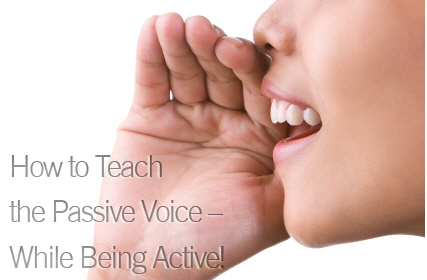How to Teach the Passive Voice – While Being Active!


Mistakes were made and corrected. Students were assigned homework, and it was handed in the following day. The students were congratulated on their efforts… do we actually speak like this? Well, certainly not all of the time, but still, the passive voice must be taught, which brings me to the point of this article: how can you teach modals in the passive voice in a way that is painless and hassle-free? I can’t guarantee it will be completely painless (it is the passive voice, after all) but here’s how you can structure your lesson so that your class doesn’t get lost in a whirlwind of mays, mights and coulds.

Review the forms of the Passive Voice that were previously taught including progressive forms. The main goal here is not only to review how the structure is formed, but also when students need to use the passive. You can play a game to get them into a “passive voice” state of mind, a game in which they can review the passive in different tenses. But what I really recommend is introducing a “topic” your students can relate to. For example, with a group of adult students, talk about what’s been happening in the city: Are streets being repaired? Was a historical site restored? Were new traffic lights installed? Will elections be held soon? In this case, we use the passive because the “subject” responsible for the action is the government, and the important thing is not the subject of every action, but rather the things that are being accomplished.
Very briefly review how we express the different degrees of probability with modals: anything “could” happen (it’s possible), but something that “may” or “might” happen is probable. Something that “should” happen is what we expect (often at a specific day or hour), and we use “must” when we reach a conclusion based on certain information given (You didn’t sleep at all last night? You must be very tired?) or when talking about obligations, responsibilities or necessities (You must pass the test to pass the course).
Now is the time to combine both, the passive voice and modals. Ask students questions about the future (future passive): Will Candidate X be elected President? (Cue the shrugging and other displays of uncertainty). Students will say yes, no or maybe. And this is when you say: Candidate X may be elected President.
T: Who else may be elected?
S: Candidate Y may be elected.
T: And Candidate Z could be elected, but that’s not very likely.
Show students the structure for using modals in the passive voice:
| Person/ object |
+ | can could may might should must |
+ | be | + | past participle of verb |
Ask questions surrounding a particular context, for example, what’s happening in your city. Ask some questions with “will” (future passive); students have to answer with the appropriate modal in passive:
T: Some streets are in bad shape. Will they be repaired?
S1: The streets should be repaired.
T: Will new street lights be installed?
S2: New lights may be installed.
Also, ask some questions of the “what happens if” type; again encourage students to use modals:
T: What happens if someone parks in a “no parking” zone?
S: A fine must be paid.
Tell students they must write a company memo in which they must remind employees of certain aspects of company policy, like dress code or basic office rules. They must try to use modals in the passive.
RE: Changes in company policy
This is a friendly reminder regarding certain office rules. The dress code for most days is “business casual”; jeans may be worn only on “casual Fridays”. And please help keep the office kitchen clean and tidy. Cups must be washed and put away. Food must not be left on the counter; it may be kept in the fridge, but please be mindful of expiration dates. Finally, I’d like to remind you that all food items that are not meant to be shared should be clearly labeled with your name and kept in the kitchen. Food must not be stored in desk drawers.
Students write up their memos and then switch with a partner, who must underline all of the modals used in passive voice. They may point out any mistakes or suggestions for correction/improvement.
Now, whether they are taught in an engaging, painless way is entirely up to you. In my experience, setting a useful context is always more helpful than random, disconnected sentences. Explain not only the grammar but also how, when and where to use it, and you can’t go wrong.